The Impact of Leadership Styles on Organizational Performance
VerifiedAdded on 2020/04/15
|15
|3707
|61
Summary
AI Summary
The document provides a comprehensive overview of leadership theories and their impact on organizational performance. It discusses how different leadership styles, such as transformational and servant leadership, shape employee behavior and organizational outcomes. Transformational leadership is noted for inspiring employees to exceed expectations through vision and motivation, while servant leadership focuses on serving followers to enhance team and organizational performance. The document also explores the role of psychological ownership in fostering a sense of belonging among employees, which can lead to improved job engagement and productivity. Furthermore, it emphasizes the importance of creating a supportive work environment that encourages creativity and innovation. Key references include studies by Hunter et al. (2013) on servant leadership, Liden et al. (2014) on its influence on performance, and Mishra et al. (2014) on driving employee engagement through communication.
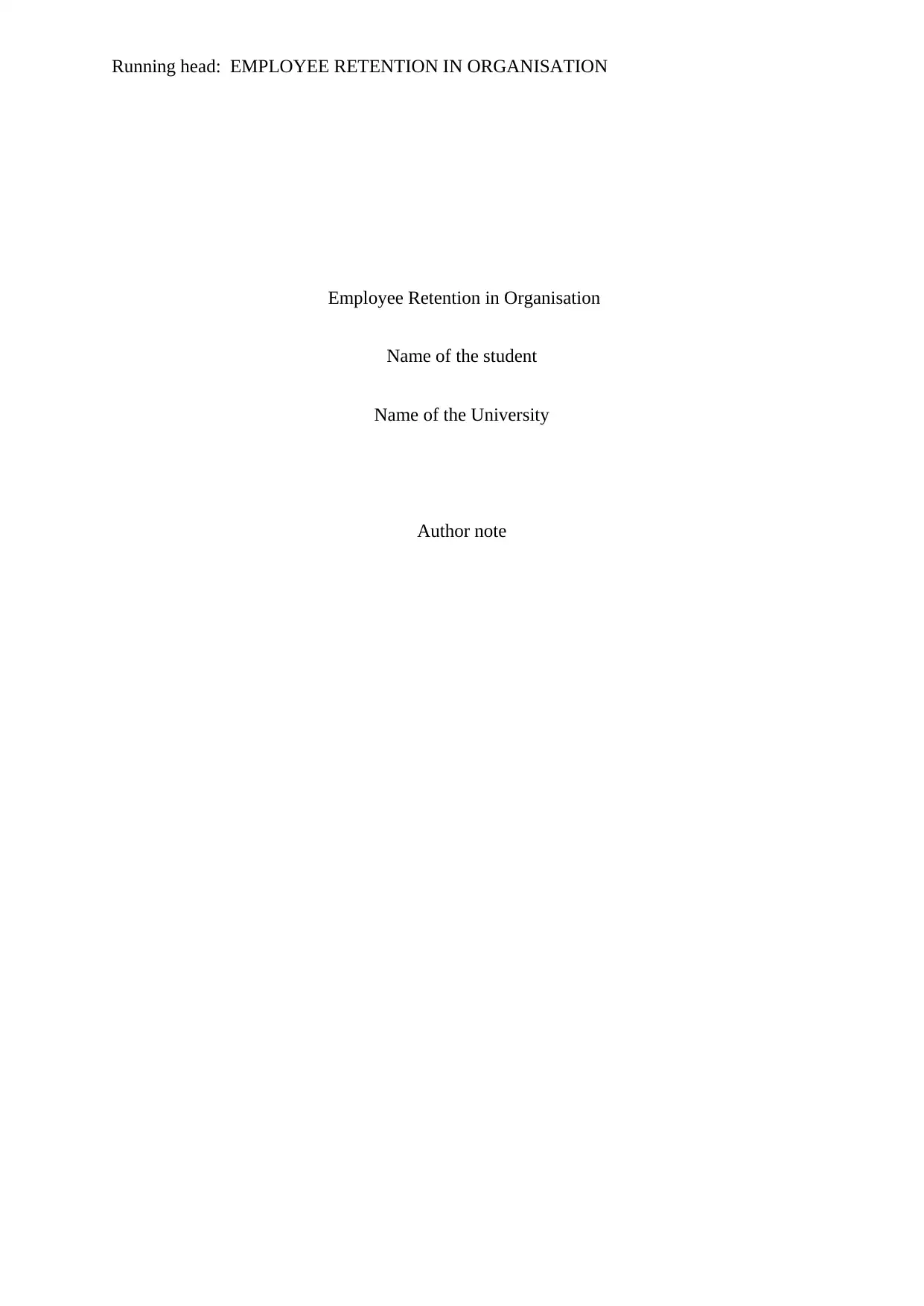
Running head: EMPLOYEE RETENTION IN ORGANISATION
Employee Retention in Organisation
Name of the student
Name of the University
Author note
Employee Retention in Organisation
Name of the student
Name of the University
Author note
Paraphrase This Document
Need a fresh take? Get an instant paraphrase of this document with our AI Paraphraser
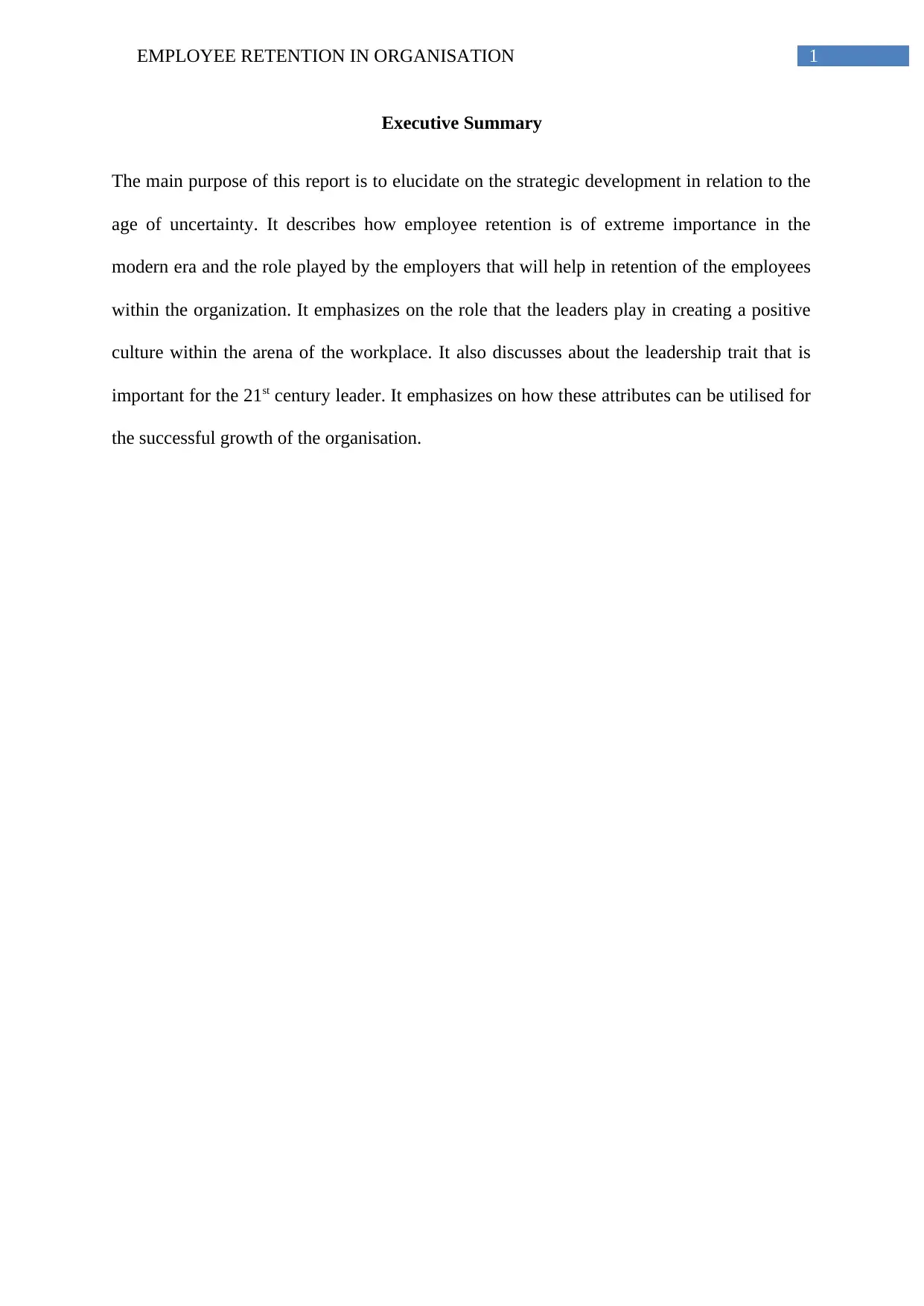
1EMPLOYEE RETENTION IN ORGANISATION
Executive Summary
The main purpose of this report is to elucidate on the strategic development in relation to the
age of uncertainty. It describes how employee retention is of extreme importance in the
modern era and the role played by the employers that will help in retention of the employees
within the organization. It emphasizes on the role that the leaders play in creating a positive
culture within the arena of the workplace. It also discusses about the leadership trait that is
important for the 21st century leader. It emphasizes on how these attributes can be utilised for
the successful growth of the organisation.
Executive Summary
The main purpose of this report is to elucidate on the strategic development in relation to the
age of uncertainty. It describes how employee retention is of extreme importance in the
modern era and the role played by the employers that will help in retention of the employees
within the organization. It emphasizes on the role that the leaders play in creating a positive
culture within the arena of the workplace. It also discusses about the leadership trait that is
important for the 21st century leader. It emphasizes on how these attributes can be utilised for
the successful growth of the organisation.
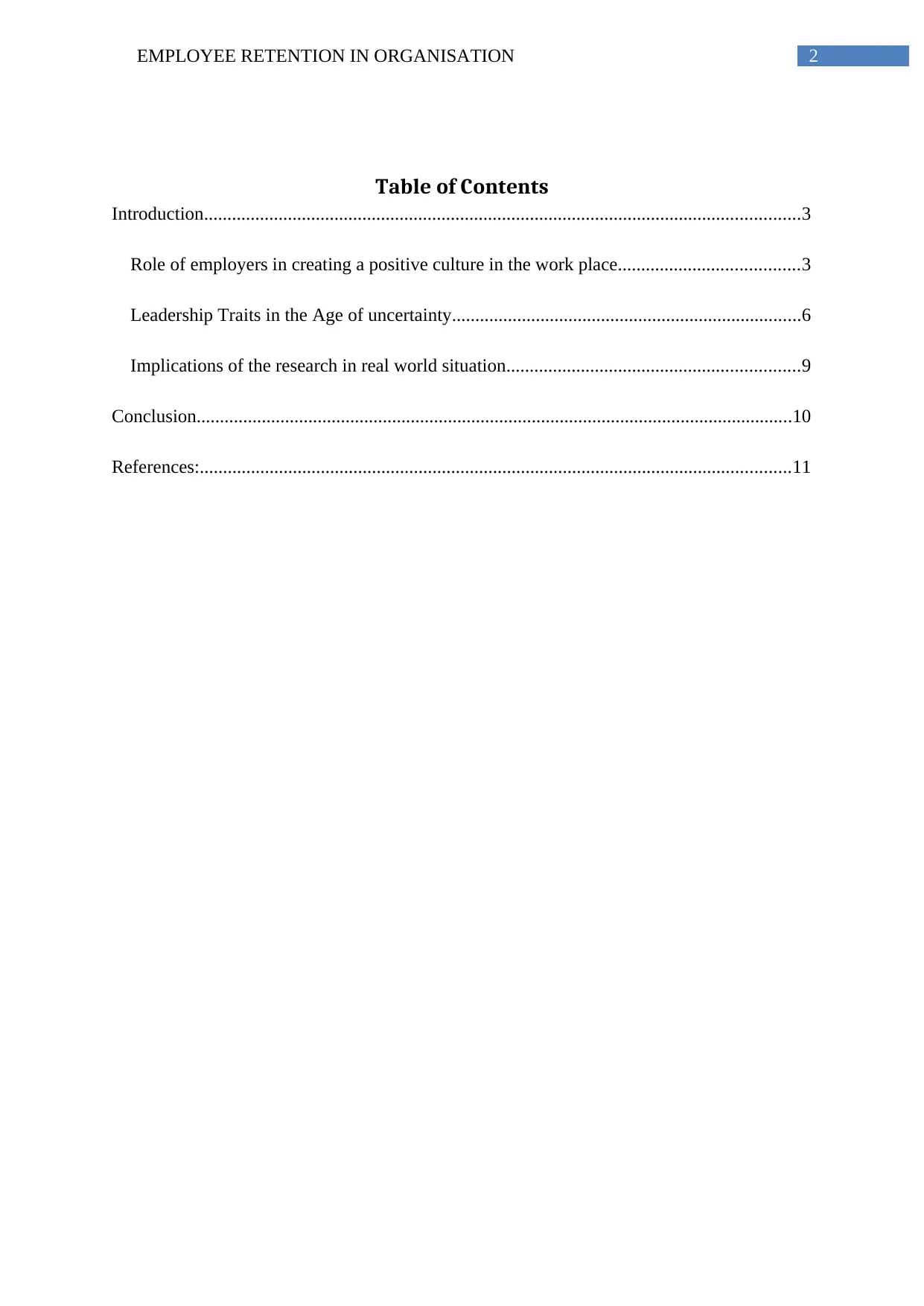
2EMPLOYEE RETENTION IN ORGANISATION
Table of Contents
Introduction................................................................................................................................3
Role of employers in creating a positive culture in the work place.......................................3
Leadership Traits in the Age of uncertainty...........................................................................6
Implications of the research in real world situation...............................................................9
Conclusion................................................................................................................................10
References:...............................................................................................................................11
Table of Contents
Introduction................................................................................................................................3
Role of employers in creating a positive culture in the work place.......................................3
Leadership Traits in the Age of uncertainty...........................................................................6
Implications of the research in real world situation...............................................................9
Conclusion................................................................................................................................10
References:...............................................................................................................................11
⊘ This is a preview!⊘
Do you want full access?
Subscribe today to unlock all pages.

Trusted by 1+ million students worldwide
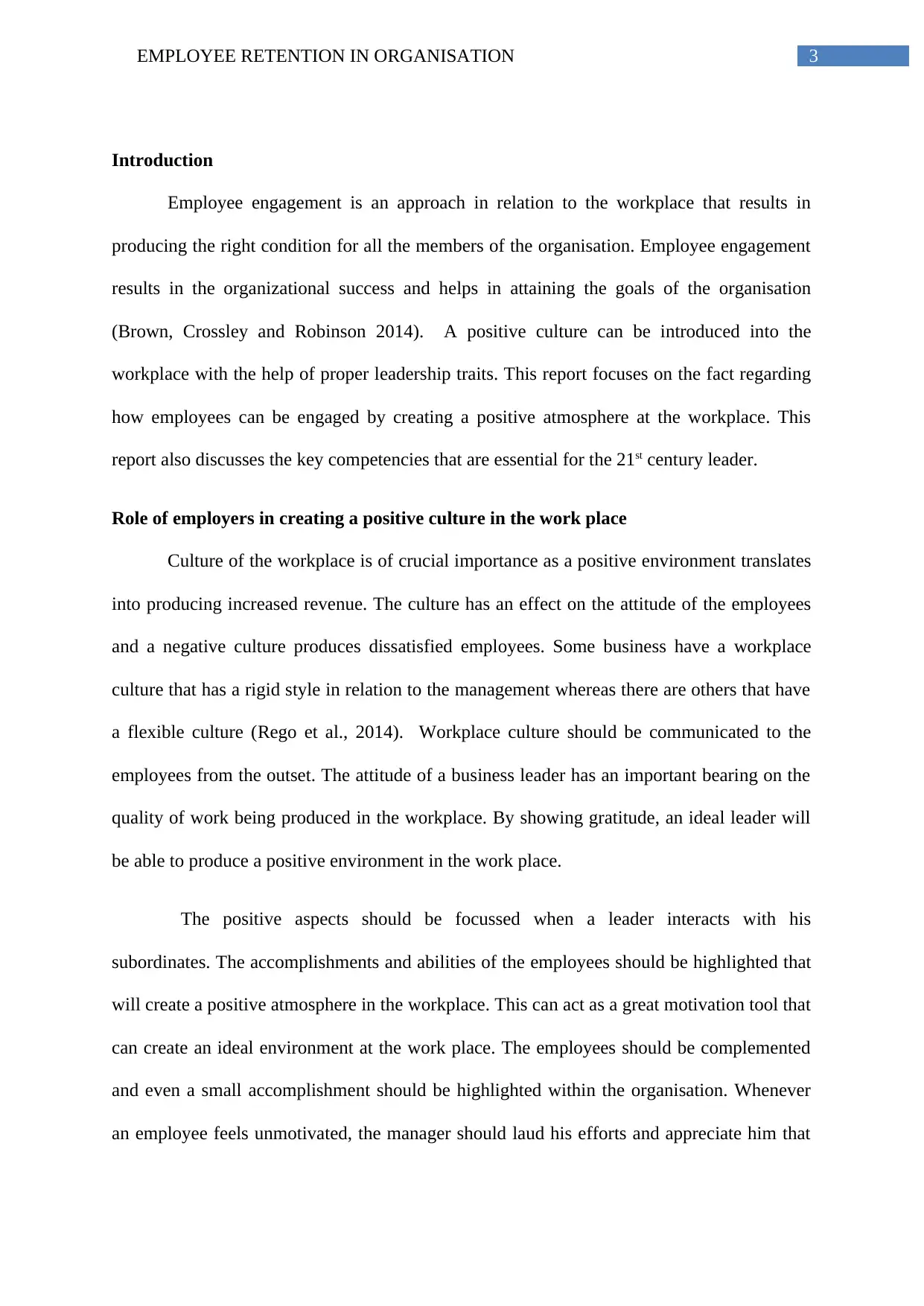
3EMPLOYEE RETENTION IN ORGANISATION
Introduction
Employee engagement is an approach in relation to the workplace that results in
producing the right condition for all the members of the organisation. Employee engagement
results in the organizational success and helps in attaining the goals of the organisation
(Brown, Crossley and Robinson 2014). A positive culture can be introduced into the
workplace with the help of proper leadership traits. This report focuses on the fact regarding
how employees can be engaged by creating a positive atmosphere at the workplace. This
report also discusses the key competencies that are essential for the 21st century leader.
Role of employers in creating a positive culture in the work place
Culture of the workplace is of crucial importance as a positive environment translates
into producing increased revenue. The culture has an effect on the attitude of the employees
and a negative culture produces dissatisfied employees. Some business have a workplace
culture that has a rigid style in relation to the management whereas there are others that have
a flexible culture (Rego et al., 2014). Workplace culture should be communicated to the
employees from the outset. The attitude of a business leader has an important bearing on the
quality of work being produced in the workplace. By showing gratitude, an ideal leader will
be able to produce a positive environment in the work place.
The positive aspects should be focussed when a leader interacts with his
subordinates. The accomplishments and abilities of the employees should be highlighted that
will create a positive atmosphere in the workplace. This can act as a great motivation tool that
can create an ideal environment at the work place. The employees should be complemented
and even a small accomplishment should be highlighted within the organisation. Whenever
an employee feels unmotivated, the manager should laud his efforts and appreciate him that
Introduction
Employee engagement is an approach in relation to the workplace that results in
producing the right condition for all the members of the organisation. Employee engagement
results in the organizational success and helps in attaining the goals of the organisation
(Brown, Crossley and Robinson 2014). A positive culture can be introduced into the
workplace with the help of proper leadership traits. This report focuses on the fact regarding
how employees can be engaged by creating a positive atmosphere at the workplace. This
report also discusses the key competencies that are essential for the 21st century leader.
Role of employers in creating a positive culture in the work place
Culture of the workplace is of crucial importance as a positive environment translates
into producing increased revenue. The culture has an effect on the attitude of the employees
and a negative culture produces dissatisfied employees. Some business have a workplace
culture that has a rigid style in relation to the management whereas there are others that have
a flexible culture (Rego et al., 2014). Workplace culture should be communicated to the
employees from the outset. The attitude of a business leader has an important bearing on the
quality of work being produced in the workplace. By showing gratitude, an ideal leader will
be able to produce a positive environment in the work place.
The positive aspects should be focussed when a leader interacts with his
subordinates. The accomplishments and abilities of the employees should be highlighted that
will create a positive atmosphere in the workplace. This can act as a great motivation tool that
can create an ideal environment at the work place. The employees should be complemented
and even a small accomplishment should be highlighted within the organisation. Whenever
an employee feels unmotivated, the manager should laud his efforts and appreciate him that
Paraphrase This Document
Need a fresh take? Get an instant paraphrase of this document with our AI Paraphraser
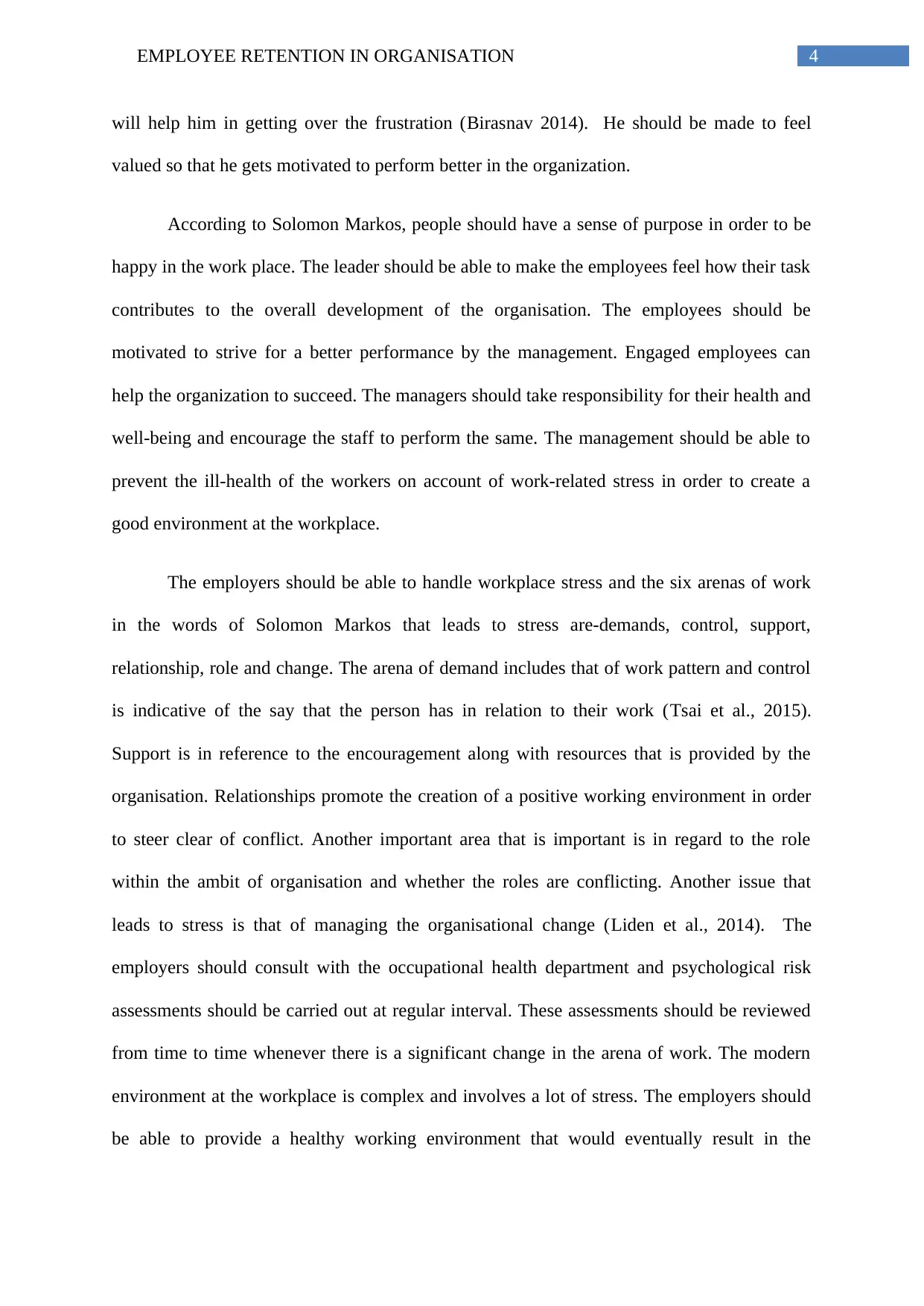
4EMPLOYEE RETENTION IN ORGANISATION
will help him in getting over the frustration (Birasnav 2014). He should be made to feel
valued so that he gets motivated to perform better in the organization.
According to Solomon Markos, people should have a sense of purpose in order to be
happy in the work place. The leader should be able to make the employees feel how their task
contributes to the overall development of the organisation. The employees should be
motivated to strive for a better performance by the management. Engaged employees can
help the organization to succeed. The managers should take responsibility for their health and
well-being and encourage the staff to perform the same. The management should be able to
prevent the ill-health of the workers on account of work-related stress in order to create a
good environment at the workplace.
The employers should be able to handle workplace stress and the six arenas of work
in the words of Solomon Markos that leads to stress are-demands, control, support,
relationship, role and change. The arena of demand includes that of work pattern and control
is indicative of the say that the person has in relation to their work (Tsai et al., 2015).
Support is in reference to the encouragement along with resources that is provided by the
organisation. Relationships promote the creation of a positive working environment in order
to steer clear of conflict. Another important area that is important is in regard to the role
within the ambit of organisation and whether the roles are conflicting. Another issue that
leads to stress is that of managing the organisational change (Liden et al., 2014). The
employers should consult with the occupational health department and psychological risk
assessments should be carried out at regular interval. These assessments should be reviewed
from time to time whenever there is a significant change in the arena of work. The modern
environment at the workplace is complex and involves a lot of stress. The employers should
be able to provide a healthy working environment that would eventually result in the
will help him in getting over the frustration (Birasnav 2014). He should be made to feel
valued so that he gets motivated to perform better in the organization.
According to Solomon Markos, people should have a sense of purpose in order to be
happy in the work place. The leader should be able to make the employees feel how their task
contributes to the overall development of the organisation. The employees should be
motivated to strive for a better performance by the management. Engaged employees can
help the organization to succeed. The managers should take responsibility for their health and
well-being and encourage the staff to perform the same. The management should be able to
prevent the ill-health of the workers on account of work-related stress in order to create a
good environment at the workplace.
The employers should be able to handle workplace stress and the six arenas of work
in the words of Solomon Markos that leads to stress are-demands, control, support,
relationship, role and change. The arena of demand includes that of work pattern and control
is indicative of the say that the person has in relation to their work (Tsai et al., 2015).
Support is in reference to the encouragement along with resources that is provided by the
organisation. Relationships promote the creation of a positive working environment in order
to steer clear of conflict. Another important area that is important is in regard to the role
within the ambit of organisation and whether the roles are conflicting. Another issue that
leads to stress is that of managing the organisational change (Liden et al., 2014). The
employers should consult with the occupational health department and psychological risk
assessments should be carried out at regular interval. These assessments should be reviewed
from time to time whenever there is a significant change in the arena of work. The modern
environment at the workplace is complex and involves a lot of stress. The employers should
be able to provide a healthy working environment that would eventually result in the
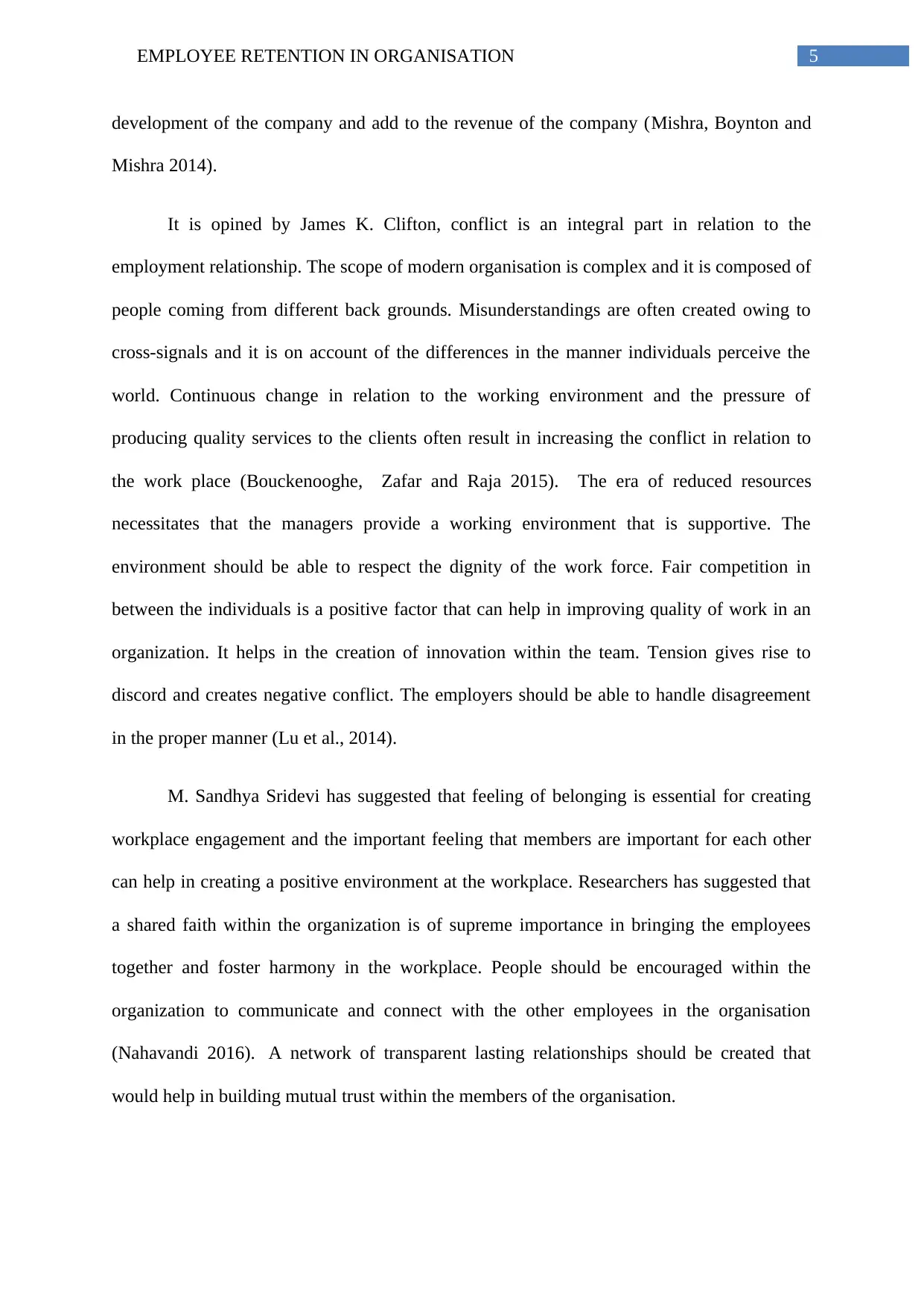
5EMPLOYEE RETENTION IN ORGANISATION
development of the company and add to the revenue of the company (Mishra, Boynton and
Mishra 2014).
It is opined by James K. Clifton, conflict is an integral part in relation to the
employment relationship. The scope of modern organisation is complex and it is composed of
people coming from different back grounds. Misunderstandings are often created owing to
cross-signals and it is on account of the differences in the manner individuals perceive the
world. Continuous change in relation to the working environment and the pressure of
producing quality services to the clients often result in increasing the conflict in relation to
the work place (Bouckenooghe, Zafar and Raja 2015). The era of reduced resources
necessitates that the managers provide a working environment that is supportive. The
environment should be able to respect the dignity of the work force. Fair competition in
between the individuals is a positive factor that can help in improving quality of work in an
organization. It helps in the creation of innovation within the team. Tension gives rise to
discord and creates negative conflict. The employers should be able to handle disagreement
in the proper manner (Lu et al., 2014).
M. Sandhya Sridevi has suggested that feeling of belonging is essential for creating
workplace engagement and the important feeling that members are important for each other
can help in creating a positive environment at the workplace. Researchers has suggested that
a shared faith within the organization is of supreme importance in bringing the employees
together and foster harmony in the workplace. People should be encouraged within the
organization to communicate and connect with the other employees in the organisation
(Nahavandi 2016). A network of transparent lasting relationships should be created that
would help in building mutual trust within the members of the organisation.
development of the company and add to the revenue of the company (Mishra, Boynton and
Mishra 2014).
It is opined by James K. Clifton, conflict is an integral part in relation to the
employment relationship. The scope of modern organisation is complex and it is composed of
people coming from different back grounds. Misunderstandings are often created owing to
cross-signals and it is on account of the differences in the manner individuals perceive the
world. Continuous change in relation to the working environment and the pressure of
producing quality services to the clients often result in increasing the conflict in relation to
the work place (Bouckenooghe, Zafar and Raja 2015). The era of reduced resources
necessitates that the managers provide a working environment that is supportive. The
environment should be able to respect the dignity of the work force. Fair competition in
between the individuals is a positive factor that can help in improving quality of work in an
organization. It helps in the creation of innovation within the team. Tension gives rise to
discord and creates negative conflict. The employers should be able to handle disagreement
in the proper manner (Lu et al., 2014).
M. Sandhya Sridevi has suggested that feeling of belonging is essential for creating
workplace engagement and the important feeling that members are important for each other
can help in creating a positive environment at the workplace. Researchers has suggested that
a shared faith within the organization is of supreme importance in bringing the employees
together and foster harmony in the workplace. People should be encouraged within the
organization to communicate and connect with the other employees in the organisation
(Nahavandi 2016). A network of transparent lasting relationships should be created that
would help in building mutual trust within the members of the organisation.
⊘ This is a preview!⊘
Do you want full access?
Subscribe today to unlock all pages.

Trusted by 1+ million students worldwide
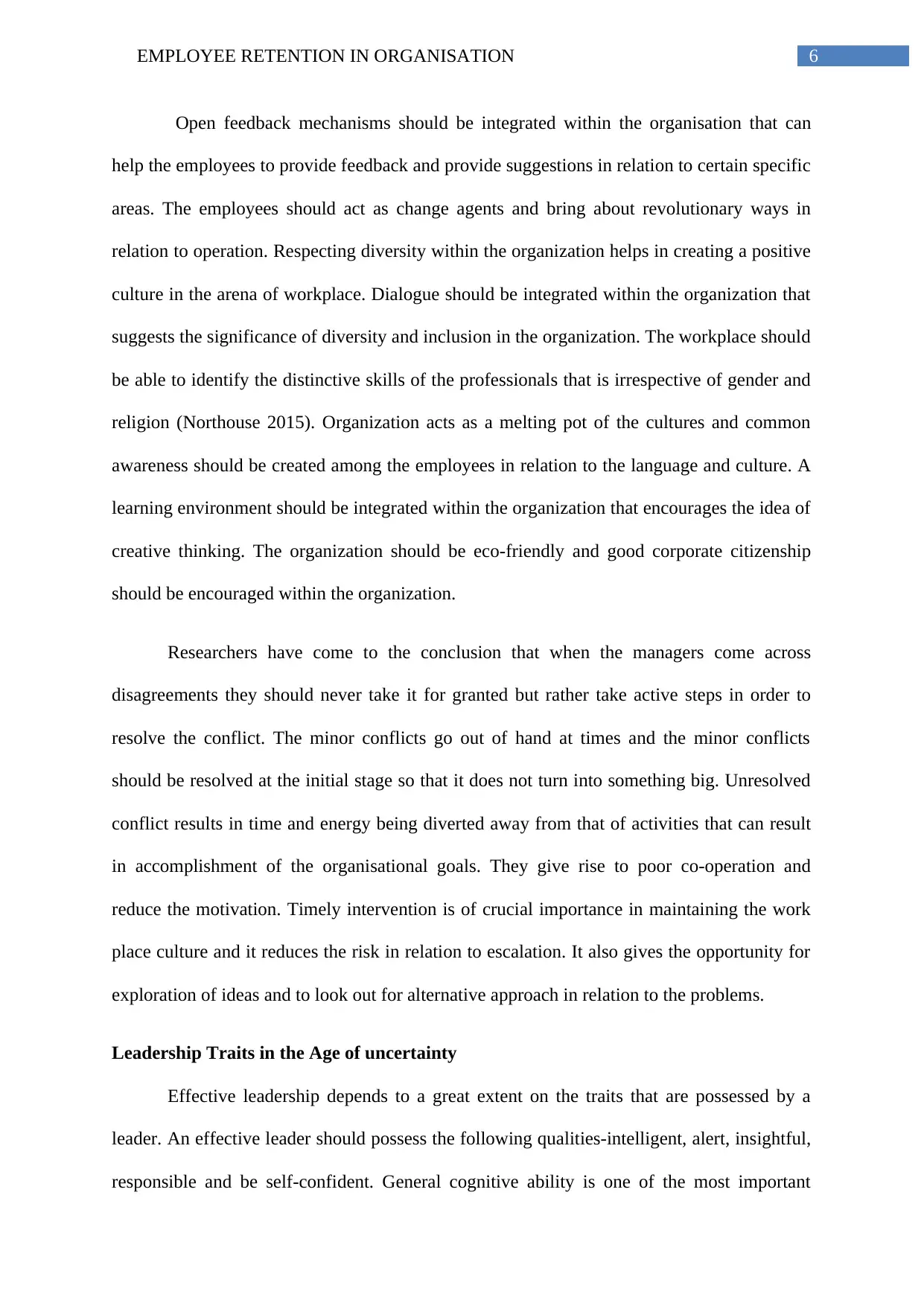
6EMPLOYEE RETENTION IN ORGANISATION
Open feedback mechanisms should be integrated within the organisation that can
help the employees to provide feedback and provide suggestions in relation to certain specific
areas. The employees should act as change agents and bring about revolutionary ways in
relation to operation. Respecting diversity within the organization helps in creating a positive
culture in the arena of workplace. Dialogue should be integrated within the organization that
suggests the significance of diversity and inclusion in the organization. The workplace should
be able to identify the distinctive skills of the professionals that is irrespective of gender and
religion (Northouse 2015). Organization acts as a melting pot of the cultures and common
awareness should be created among the employees in relation to the language and culture. A
learning environment should be integrated within the organization that encourages the idea of
creative thinking. The organization should be eco-friendly and good corporate citizenship
should be encouraged within the organization.
Researchers have come to the conclusion that when the managers come across
disagreements they should never take it for granted but rather take active steps in order to
resolve the conflict. The minor conflicts go out of hand at times and the minor conflicts
should be resolved at the initial stage so that it does not turn into something big. Unresolved
conflict results in time and energy being diverted away from that of activities that can result
in accomplishment of the organisational goals. They give rise to poor co-operation and
reduce the motivation. Timely intervention is of crucial importance in maintaining the work
place culture and it reduces the risk in relation to escalation. It also gives the opportunity for
exploration of ideas and to look out for alternative approach in relation to the problems.
Leadership Traits in the Age of uncertainty
Effective leadership depends to a great extent on the traits that are possessed by a
leader. An effective leader should possess the following qualities-intelligent, alert, insightful,
responsible and be self-confident. General cognitive ability is one of the most important
Open feedback mechanisms should be integrated within the organisation that can
help the employees to provide feedback and provide suggestions in relation to certain specific
areas. The employees should act as change agents and bring about revolutionary ways in
relation to operation. Respecting diversity within the organization helps in creating a positive
culture in the arena of workplace. Dialogue should be integrated within the organization that
suggests the significance of diversity and inclusion in the organization. The workplace should
be able to identify the distinctive skills of the professionals that is irrespective of gender and
religion (Northouse 2015). Organization acts as a melting pot of the cultures and common
awareness should be created among the employees in relation to the language and culture. A
learning environment should be integrated within the organization that encourages the idea of
creative thinking. The organization should be eco-friendly and good corporate citizenship
should be encouraged within the organization.
Researchers have come to the conclusion that when the managers come across
disagreements they should never take it for granted but rather take active steps in order to
resolve the conflict. The minor conflicts go out of hand at times and the minor conflicts
should be resolved at the initial stage so that it does not turn into something big. Unresolved
conflict results in time and energy being diverted away from that of activities that can result
in accomplishment of the organisational goals. They give rise to poor co-operation and
reduce the motivation. Timely intervention is of crucial importance in maintaining the work
place culture and it reduces the risk in relation to escalation. It also gives the opportunity for
exploration of ideas and to look out for alternative approach in relation to the problems.
Leadership Traits in the Age of uncertainty
Effective leadership depends to a great extent on the traits that are possessed by a
leader. An effective leader should possess the following qualities-intelligent, alert, insightful,
responsible and be self-confident. General cognitive ability is one of the most important
Paraphrase This Document
Need a fresh take? Get an instant paraphrase of this document with our AI Paraphraser
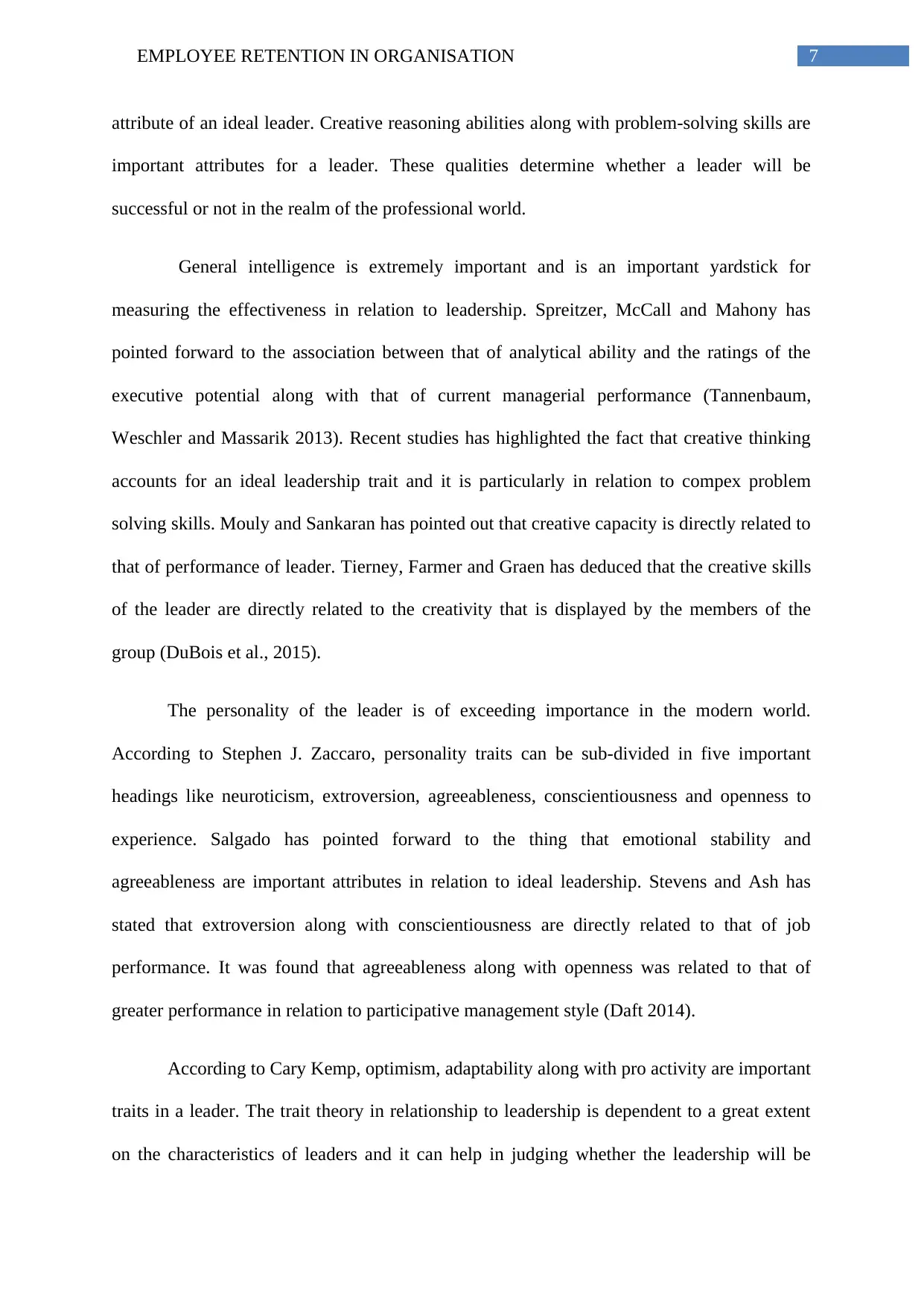
7EMPLOYEE RETENTION IN ORGANISATION
attribute of an ideal leader. Creative reasoning abilities along with problem-solving skills are
important attributes for a leader. These qualities determine whether a leader will be
successful or not in the realm of the professional world.
General intelligence is extremely important and is an important yardstick for
measuring the effectiveness in relation to leadership. Spreitzer, McCall and Mahony has
pointed forward to the association between that of analytical ability and the ratings of the
executive potential along with that of current managerial performance (Tannenbaum,
Weschler and Massarik 2013). Recent studies has highlighted the fact that creative thinking
accounts for an ideal leadership trait and it is particularly in relation to compex problem
solving skills. Mouly and Sankaran has pointed out that creative capacity is directly related to
that of performance of leader. Tierney, Farmer and Graen has deduced that the creative skills
of the leader are directly related to the creativity that is displayed by the members of the
group (DuBois et al., 2015).
The personality of the leader is of exceeding importance in the modern world.
According to Stephen J. Zaccaro, personality traits can be sub-divided in five important
headings like neuroticism, extroversion, agreeableness, conscientiousness and openness to
experience. Salgado has pointed forward to the thing that emotional stability and
agreeableness are important attributes in relation to ideal leadership. Stevens and Ash has
stated that extroversion along with conscientiousness are directly related to that of job
performance. It was found that agreeableness along with openness was related to that of
greater performance in relation to participative management style (Daft 2014).
According to Cary Kemp, optimism, adaptability along with pro activity are important
traits in a leader. The trait theory in relationship to leadership is dependent to a great extent
on the characteristics of leaders and it can help in judging whether the leadership will be
attribute of an ideal leader. Creative reasoning abilities along with problem-solving skills are
important attributes for a leader. These qualities determine whether a leader will be
successful or not in the realm of the professional world.
General intelligence is extremely important and is an important yardstick for
measuring the effectiveness in relation to leadership. Spreitzer, McCall and Mahony has
pointed forward to the association between that of analytical ability and the ratings of the
executive potential along with that of current managerial performance (Tannenbaum,
Weschler and Massarik 2013). Recent studies has highlighted the fact that creative thinking
accounts for an ideal leadership trait and it is particularly in relation to compex problem
solving skills. Mouly and Sankaran has pointed out that creative capacity is directly related to
that of performance of leader. Tierney, Farmer and Graen has deduced that the creative skills
of the leader are directly related to the creativity that is displayed by the members of the
group (DuBois et al., 2015).
The personality of the leader is of exceeding importance in the modern world.
According to Stephen J. Zaccaro, personality traits can be sub-divided in five important
headings like neuroticism, extroversion, agreeableness, conscientiousness and openness to
experience. Salgado has pointed forward to the thing that emotional stability and
agreeableness are important attributes in relation to ideal leadership. Stevens and Ash has
stated that extroversion along with conscientiousness are directly related to that of job
performance. It was found that agreeableness along with openness was related to that of
greater performance in relation to participative management style (Daft 2014).
According to Cary Kemp, optimism, adaptability along with pro activity are important
traits in a leader. The trait theory in relationship to leadership is dependent to a great extent
on the characteristics of leaders and it can help in judging whether the leadership will be
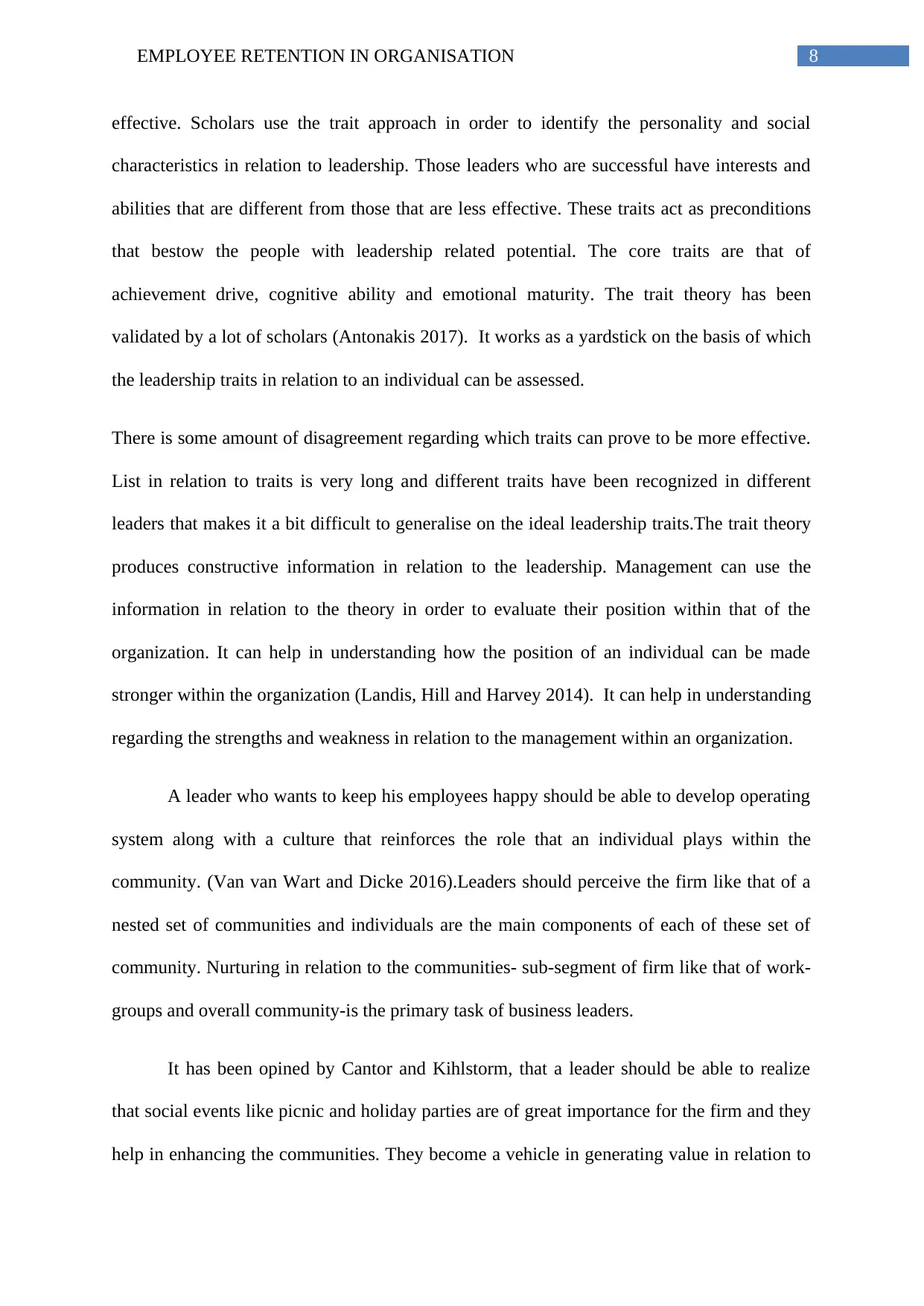
8EMPLOYEE RETENTION IN ORGANISATION
effective. Scholars use the trait approach in order to identify the personality and social
characteristics in relation to leadership. Those leaders who are successful have interests and
abilities that are different from those that are less effective. These traits act as preconditions
that bestow the people with leadership related potential. The core traits are that of
achievement drive, cognitive ability and emotional maturity. The trait theory has been
validated by a lot of scholars (Antonakis 2017). It works as a yardstick on the basis of which
the leadership traits in relation to an individual can be assessed.
There is some amount of disagreement regarding which traits can prove to be more effective.
List in relation to traits is very long and different traits have been recognized in different
leaders that makes it a bit difficult to generalise on the ideal leadership traits.The trait theory
produces constructive information in relation to the leadership. Management can use the
information in relation to the theory in order to evaluate their position within that of the
organization. It can help in understanding how the position of an individual can be made
stronger within the organization (Landis, Hill and Harvey 2014). It can help in understanding
regarding the strengths and weakness in relation to the management within an organization.
A leader who wants to keep his employees happy should be able to develop operating
system along with a culture that reinforces the role that an individual plays within the
community. (Van van Wart and Dicke 2016).Leaders should perceive the firm like that of a
nested set of communities and individuals are the main components of each of these set of
community. Nurturing in relation to the communities- sub-segment of firm like that of work-
groups and overall community-is the primary task of business leaders.
It has been opined by Cantor and Kihlstorm, that a leader should be able to realize
that social events like picnic and holiday parties are of great importance for the firm and they
help in enhancing the communities. They become a vehicle in generating value in relation to
effective. Scholars use the trait approach in order to identify the personality and social
characteristics in relation to leadership. Those leaders who are successful have interests and
abilities that are different from those that are less effective. These traits act as preconditions
that bestow the people with leadership related potential. The core traits are that of
achievement drive, cognitive ability and emotional maturity. The trait theory has been
validated by a lot of scholars (Antonakis 2017). It works as a yardstick on the basis of which
the leadership traits in relation to an individual can be assessed.
There is some amount of disagreement regarding which traits can prove to be more effective.
List in relation to traits is very long and different traits have been recognized in different
leaders that makes it a bit difficult to generalise on the ideal leadership traits.The trait theory
produces constructive information in relation to the leadership. Management can use the
information in relation to the theory in order to evaluate their position within that of the
organization. It can help in understanding how the position of an individual can be made
stronger within the organization (Landis, Hill and Harvey 2014). It can help in understanding
regarding the strengths and weakness in relation to the management within an organization.
A leader who wants to keep his employees happy should be able to develop operating
system along with a culture that reinforces the role that an individual plays within the
community. (Van van Wart and Dicke 2016).Leaders should perceive the firm like that of a
nested set of communities and individuals are the main components of each of these set of
community. Nurturing in relation to the communities- sub-segment of firm like that of work-
groups and overall community-is the primary task of business leaders.
It has been opined by Cantor and Kihlstorm, that a leader should be able to realize
that social events like picnic and holiday parties are of great importance for the firm and they
help in enhancing the communities. They become a vehicle in generating value in relation to
⊘ This is a preview!⊘
Do you want full access?
Subscribe today to unlock all pages.

Trusted by 1+ million students worldwide
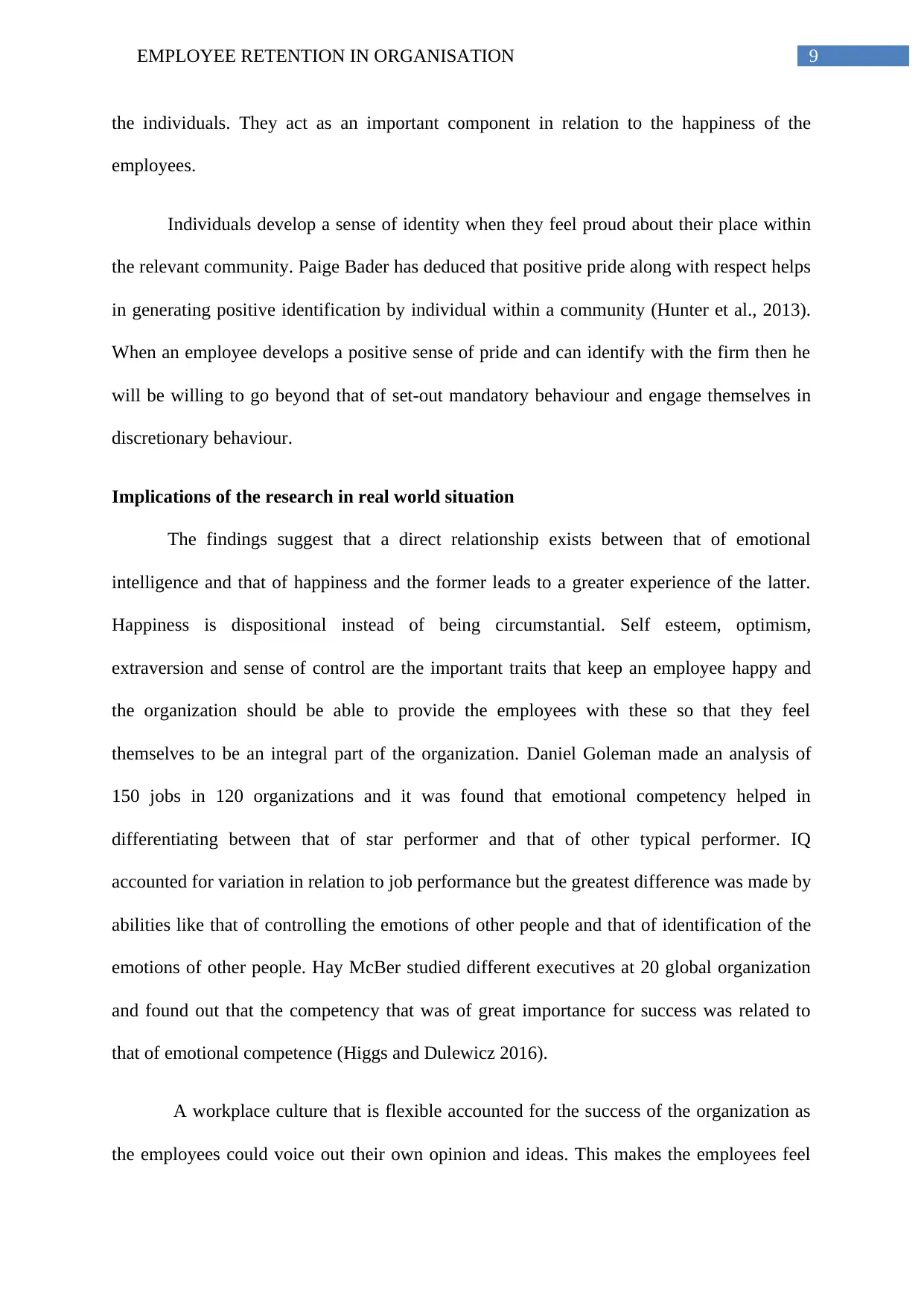
9EMPLOYEE RETENTION IN ORGANISATION
the individuals. They act as an important component in relation to the happiness of the
employees.
Individuals develop a sense of identity when they feel proud about their place within
the relevant community. Paige Bader has deduced that positive pride along with respect helps
in generating positive identification by individual within a community (Hunter et al., 2013).
When an employee develops a positive sense of pride and can identify with the firm then he
will be willing to go beyond that of set-out mandatory behaviour and engage themselves in
discretionary behaviour.
Implications of the research in real world situation
The findings suggest that a direct relationship exists between that of emotional
intelligence and that of happiness and the former leads to a greater experience of the latter.
Happiness is dispositional instead of being circumstantial. Self esteem, optimism,
extraversion and sense of control are the important traits that keep an employee happy and
the organization should be able to provide the employees with these so that they feel
themselves to be an integral part of the organization. Daniel Goleman made an analysis of
150 jobs in 120 organizations and it was found that emotional competency helped in
differentiating between that of star performer and that of other typical performer. IQ
accounted for variation in relation to job performance but the greatest difference was made by
abilities like that of controlling the emotions of other people and that of identification of the
emotions of other people. Hay McBer studied different executives at 20 global organization
and found out that the competency that was of great importance for success was related to
that of emotional competence (Higgs and Dulewicz 2016).
A workplace culture that is flexible accounted for the success of the organization as
the employees could voice out their own opinion and ideas. This makes the employees feel
the individuals. They act as an important component in relation to the happiness of the
employees.
Individuals develop a sense of identity when they feel proud about their place within
the relevant community. Paige Bader has deduced that positive pride along with respect helps
in generating positive identification by individual within a community (Hunter et al., 2013).
When an employee develops a positive sense of pride and can identify with the firm then he
will be willing to go beyond that of set-out mandatory behaviour and engage themselves in
discretionary behaviour.
Implications of the research in real world situation
The findings suggest that a direct relationship exists between that of emotional
intelligence and that of happiness and the former leads to a greater experience of the latter.
Happiness is dispositional instead of being circumstantial. Self esteem, optimism,
extraversion and sense of control are the important traits that keep an employee happy and
the organization should be able to provide the employees with these so that they feel
themselves to be an integral part of the organization. Daniel Goleman made an analysis of
150 jobs in 120 organizations and it was found that emotional competency helped in
differentiating between that of star performer and that of other typical performer. IQ
accounted for variation in relation to job performance but the greatest difference was made by
abilities like that of controlling the emotions of other people and that of identification of the
emotions of other people. Hay McBer studied different executives at 20 global organization
and found out that the competency that was of great importance for success was related to
that of emotional competence (Higgs and Dulewicz 2016).
A workplace culture that is flexible accounted for the success of the organization as
the employees could voice out their own opinion and ideas. This makes the employees feel
Paraphrase This Document
Need a fresh take? Get an instant paraphrase of this document with our AI Paraphraser
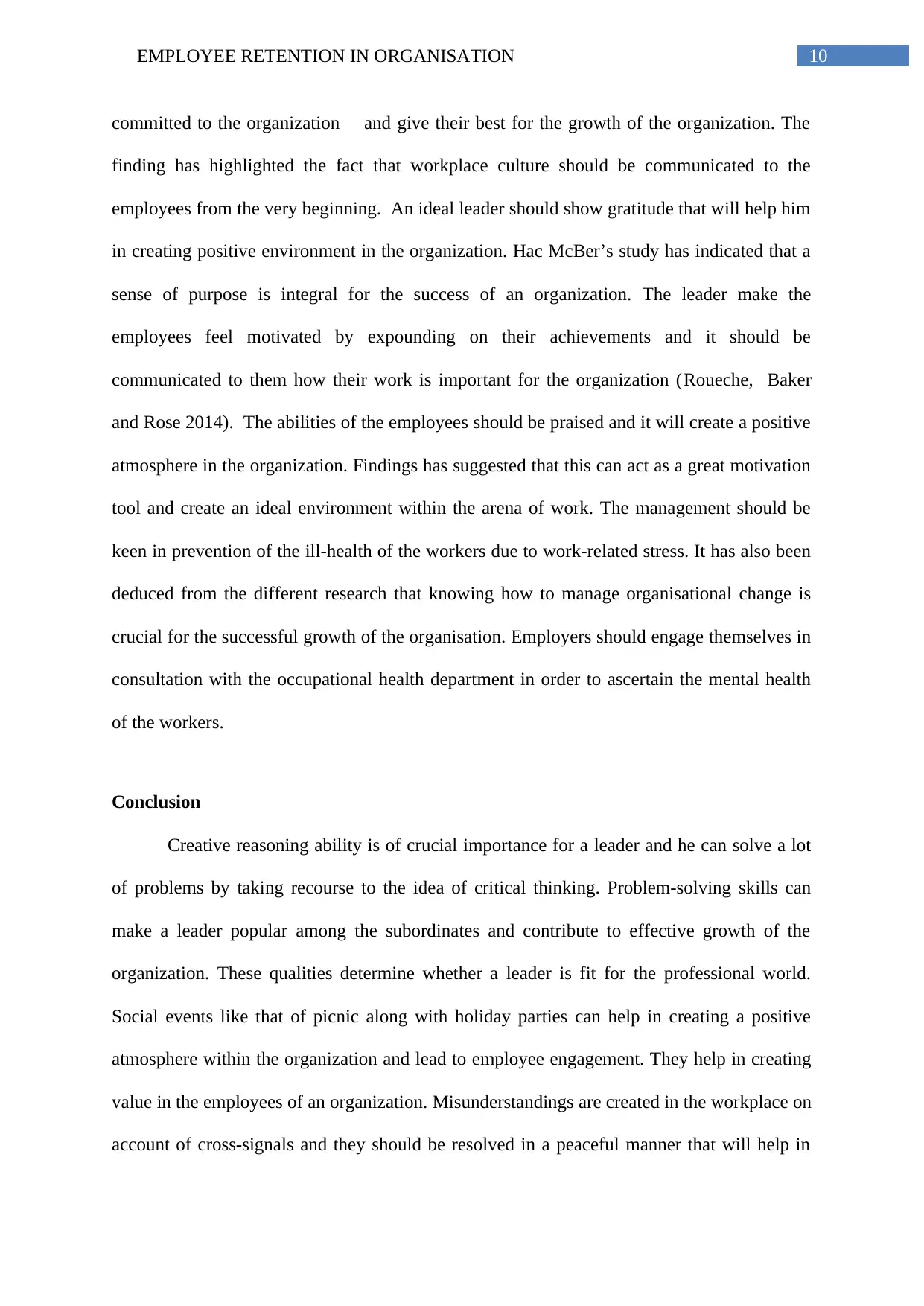
10EMPLOYEE RETENTION IN ORGANISATION
committed to the organization and give their best for the growth of the organization. The
finding has highlighted the fact that workplace culture should be communicated to the
employees from the very beginning. An ideal leader should show gratitude that will help him
in creating positive environment in the organization. Hac McBer’s study has indicated that a
sense of purpose is integral for the success of an organization. The leader make the
employees feel motivated by expounding on their achievements and it should be
communicated to them how their work is important for the organization (Roueche, Baker
and Rose 2014). The abilities of the employees should be praised and it will create a positive
atmosphere in the organization. Findings has suggested that this can act as a great motivation
tool and create an ideal environment within the arena of work. The management should be
keen in prevention of the ill-health of the workers due to work-related stress. It has also been
deduced from the different research that knowing how to manage organisational change is
crucial for the successful growth of the organisation. Employers should engage themselves in
consultation with the occupational health department in order to ascertain the mental health
of the workers.
Conclusion
Creative reasoning ability is of crucial importance for a leader and he can solve a lot
of problems by taking recourse to the idea of critical thinking. Problem-solving skills can
make a leader popular among the subordinates and contribute to effective growth of the
organization. These qualities determine whether a leader is fit for the professional world.
Social events like that of picnic along with holiday parties can help in creating a positive
atmosphere within the organization and lead to employee engagement. They help in creating
value in the employees of an organization. Misunderstandings are created in the workplace on
account of cross-signals and they should be resolved in a peaceful manner that will help in
committed to the organization and give their best for the growth of the organization. The
finding has highlighted the fact that workplace culture should be communicated to the
employees from the very beginning. An ideal leader should show gratitude that will help him
in creating positive environment in the organization. Hac McBer’s study has indicated that a
sense of purpose is integral for the success of an organization. The leader make the
employees feel motivated by expounding on their achievements and it should be
communicated to them how their work is important for the organization (Roueche, Baker
and Rose 2014). The abilities of the employees should be praised and it will create a positive
atmosphere in the organization. Findings has suggested that this can act as a great motivation
tool and create an ideal environment within the arena of work. The management should be
keen in prevention of the ill-health of the workers due to work-related stress. It has also been
deduced from the different research that knowing how to manage organisational change is
crucial for the successful growth of the organisation. Employers should engage themselves in
consultation with the occupational health department in order to ascertain the mental health
of the workers.
Conclusion
Creative reasoning ability is of crucial importance for a leader and he can solve a lot
of problems by taking recourse to the idea of critical thinking. Problem-solving skills can
make a leader popular among the subordinates and contribute to effective growth of the
organization. These qualities determine whether a leader is fit for the professional world.
Social events like that of picnic along with holiday parties can help in creating a positive
atmosphere within the organization and lead to employee engagement. They help in creating
value in the employees of an organization. Misunderstandings are created in the workplace on
account of cross-signals and they should be resolved in a peaceful manner that will help in
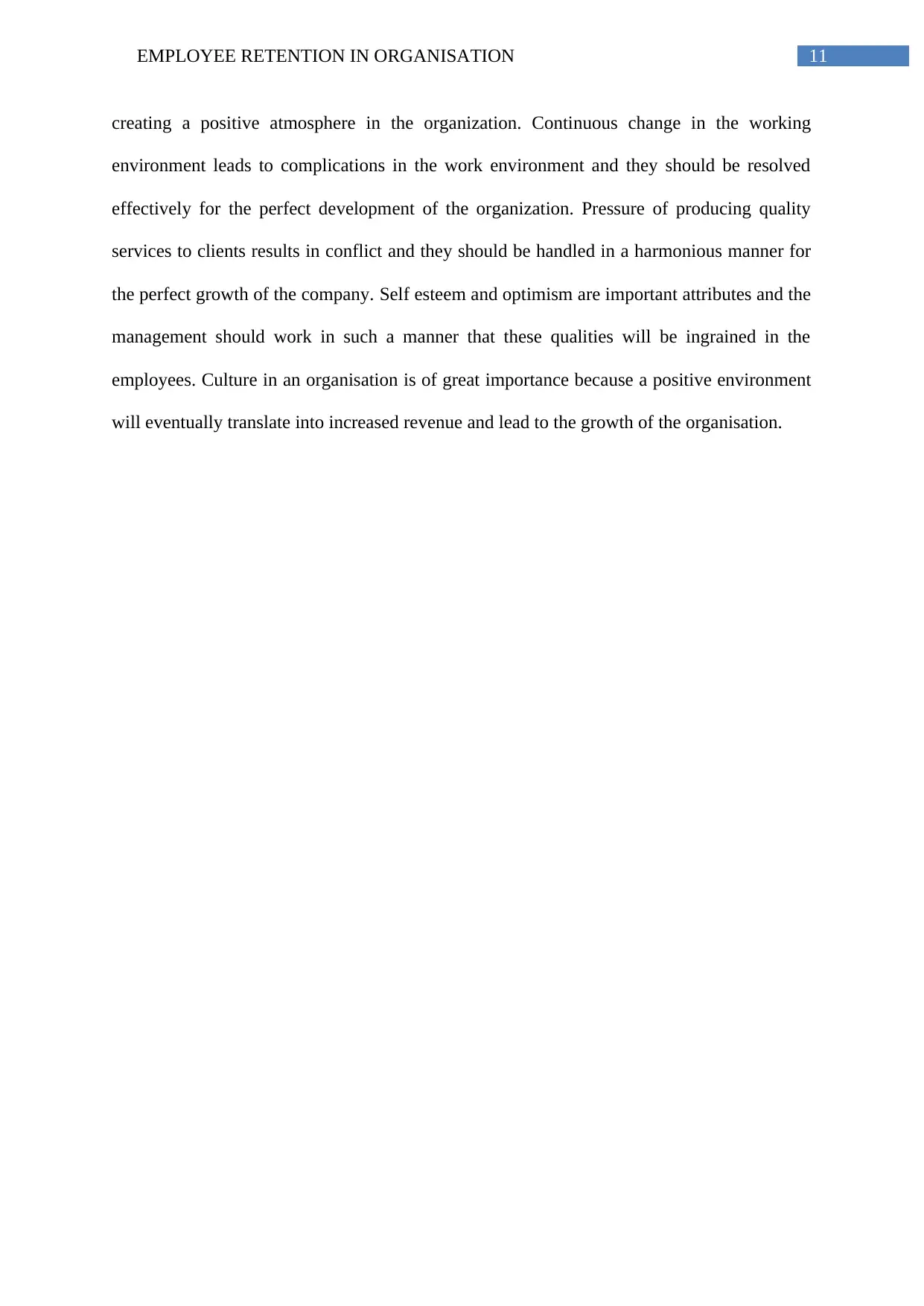
11EMPLOYEE RETENTION IN ORGANISATION
creating a positive atmosphere in the organization. Continuous change in the working
environment leads to complications in the work environment and they should be resolved
effectively for the perfect development of the organization. Pressure of producing quality
services to clients results in conflict and they should be handled in a harmonious manner for
the perfect growth of the company. Self esteem and optimism are important attributes and the
management should work in such a manner that these qualities will be ingrained in the
employees. Culture in an organisation is of great importance because a positive environment
will eventually translate into increased revenue and lead to the growth of the organisation.
creating a positive atmosphere in the organization. Continuous change in the working
environment leads to complications in the work environment and they should be resolved
effectively for the perfect development of the organization. Pressure of producing quality
services to clients results in conflict and they should be handled in a harmonious manner for
the perfect growth of the company. Self esteem and optimism are important attributes and the
management should work in such a manner that these qualities will be ingrained in the
employees. Culture in an organisation is of great importance because a positive environment
will eventually translate into increased revenue and lead to the growth of the organisation.
⊘ This is a preview!⊘
Do you want full access?
Subscribe today to unlock all pages.

Trusted by 1+ million students worldwide
1 out of 15
Related Documents
Your All-in-One AI-Powered Toolkit for Academic Success.
+13062052269
info@desklib.com
Available 24*7 on WhatsApp / Email
![[object Object]](/_next/static/media/star-bottom.7253800d.svg)
Unlock your academic potential
Copyright © 2020–2025 A2Z Services. All Rights Reserved. Developed and managed by ZUCOL.




